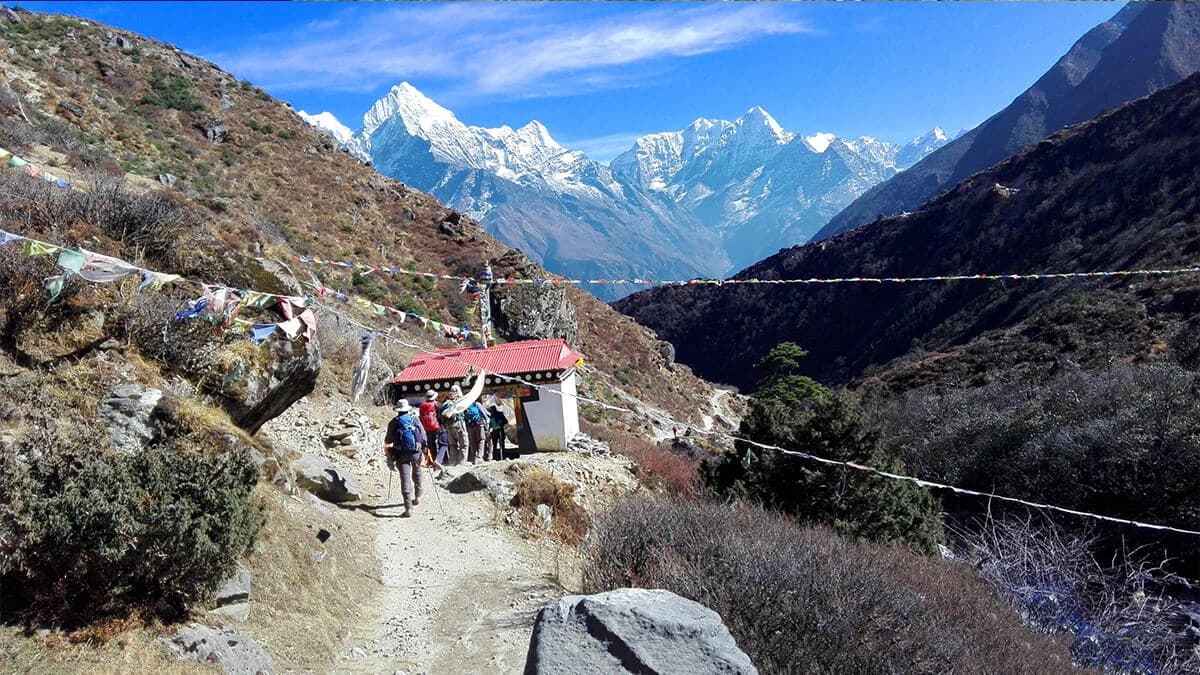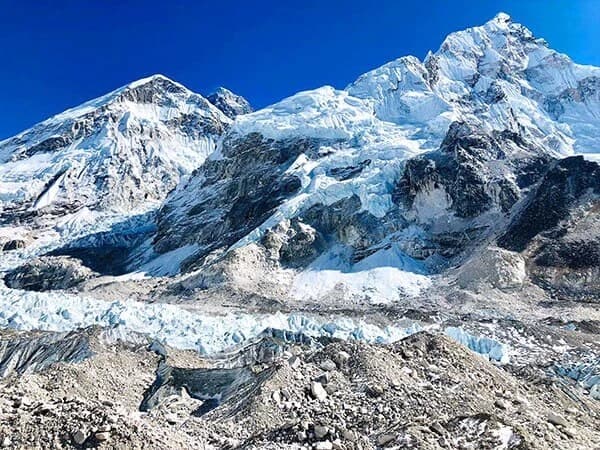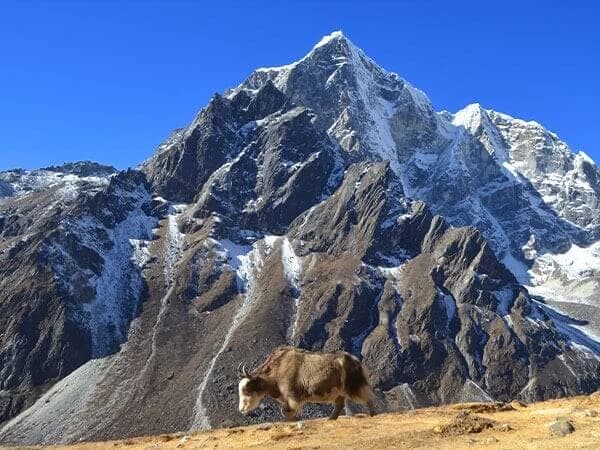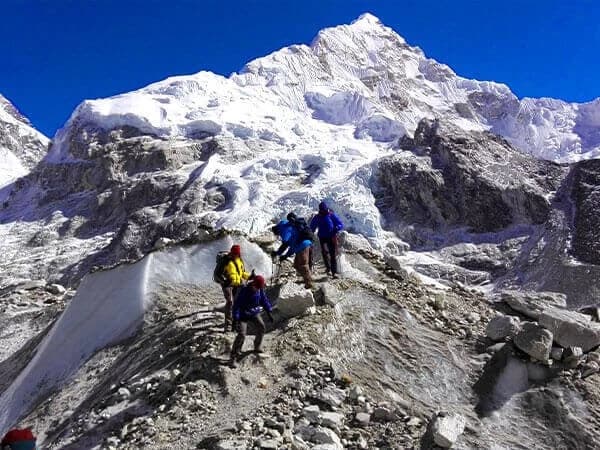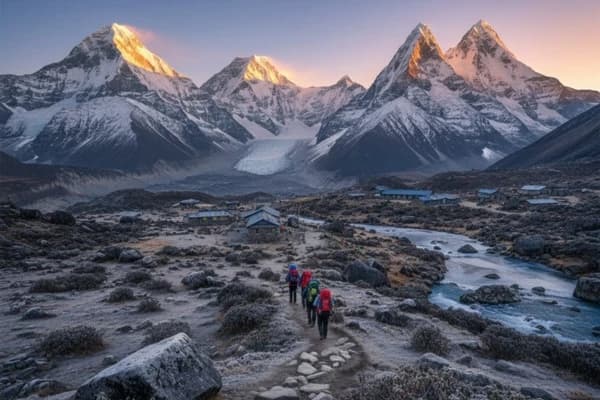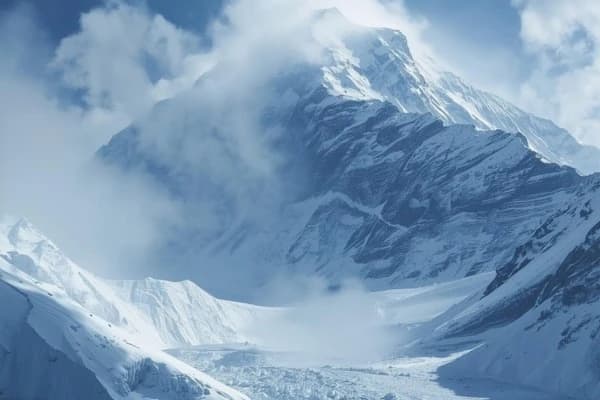Everest Base Camp Trekking Route Map: Complete information about Everest Base Camp trek routes with various options via Gokyo, Rolwalling, Jiri, and Mera-La Pass.
Different Trekking Route Map to Everest Base Camp
The Everest Base Camp Trek is the best and most famous trekking trail for travel lovers worldwide. The EBC Trek route takes you up to 5364 m above sea level. This is the last point you can reach near Mt. Everest without a special permit.
This blog provides various trekking routes to Mt. Everest Base Camp. If you have any suggestions about these routes, please comment or use our contact form to contact us directly.
Various Trekking Routes to reach Everest Base Camp
- Standard and popular EBC Trek route (Lukla-Namche-Gorakshep-Everest Base Camp)
- Classic EBC route (Jiri-Bhandar-Lamjura Pass-Namche-Gorakshep-EBC)
- Kathmandu-Phaplu (flight/drive)-Namche-Gorakshep-EBC
- Lukla, Namche, Gokyo Valley, Cho-la Pass, EBC
- Lukla Mera Peak Amphu Lapcha Pass, Chukung Kongma-la Pass, EBC
- Rolwaling Tashi laptsa Pass Thame Namche EBC
Standard and Popular EBC Trek Route (Lukla-Namche-Gorakshep-Everest Base Camp)
This is the most popular and easy route to Everest Base Camp. You will take a flight from Kathmandu to Lukla and then start trekking from there. If you are an experienced trekker, this route can be completed in 12 days. Normally, it takes 14 days to complete.
Kathmandu Lukla Namche Everest Base Camp Trekking Route Map
- Kathmandu to Lukla (2840 m) flight and trek to Phakding (2660 m). Walking 3 hours
- Trek to Namche Bazaar (3440 m). Walking 6–7 hours
- Trek to Tengboche (3860 m). Walking 5 hours
- Trek to Dingboche (4410 m). Walking 5 hours
- Trek to Lobuche (4910 m). Walking 5 hours
- Trek to Everest Base Camp (5364 m). Walking 7 hours

Classic EBC Trek Route (Jiri-Bhandar-Lamjura Pass-Namche-Gorakshep-EBC)
This is a classic Everest base camp trekking route. The Jiri Everest base camp trekking route was the most popular before Lukla Airport started operating. This route allows you to spend more days in the Everest region. This route can be completed in 16 to 22 days, depending on your previous experience and walking capacity.
Jiri Everest Base Camp Trekking Route Map
- Drive from Kathmandu to Bhandara (1955 m) via Jiri.
- Trek Bhandara to Sete (2645 m).
- Sete to Junbesi (2640 m).
- Junbesi to Nuntala (2440 m).
- Nuntala to Kharikhola (2020 m).
- Kharikhola to Pyau (2700 m).
- Pyau to Phakding (2640 m).
- Phakding to Namche Bazar (3440 m).
- From Namche, follow the same route as the Kathmandu-Lukla-EBC trekking route.
Kathmandu-Phaplu-Namche-Gorakshep-Everest Base Camp Trek Route
This trekking route is an alternative for trekkers who don't want to fly to Lukla or want to explore more of the Everest region. You can take a 30-minute flight from Kathmandu to Phaplu or an 8-10-hour road trip. Depending on your experience and walking capacity, this route can be completed in 16 to 18 days.
Phaplu Everest Base Camp Trekking Route Map
- Fly from Kathmandu to Phaplu (2364 m).
- Phaplu to Nunthala (2200 m) to Bupsa (2350 m).
- Bupsa (2350 m) to Surkey (2400 m).
- Surkey (2400 m) to Phakding (2652 m).
- From here we will follow the same route as the Kathmandu-Lukla-EBC trek.
4. Lukla Namche Gokyo Valley Cho-la Pass EBC Trek Route
Everest Base Camp via Gokyo Valley Trek is an alternative route that combines Everest Base Camp trekking with Chola Pass adventure. This route is more challenging than the normal Everest base camp trekking route. The main highlight of this route is that you will be able to see four peaks over 8,000 meters among the eight in Nepal. This route normally takes 15 to 17 days to complete.
Gokyo Chola Pass EBC Trekking Route Map
- Fly to Lukla (30 minutes) and trek to Phakding.
- Phakding to Namche Bazaar.
- Namche to Dole.
- Dole to Machhermo.
- Machhermo to Gokyo Valley.
- Gokyo Valley to Tagnag (4,700 m).
- Tagnag to Dzonglha (4,830 m) via Cho La Pass (5,420 m).
- Dzonglha to Lobuche (4,940 m).
- Lobuche-Gorak Shep (5,160 m)-Everest Base Camp (5,364 m).
5. Lukla Mera Peak, Amphu Laptcha Pass, Chukung Kongma-la Pass, EBC
This trekking route is one of the most challenging, and proper climbing gear and basic climbing knowledge are needed. This is the perfect route for an Everest base camp trek with adventure and some climbing experience.
The Everest base camp trek via Mera La (Amphu Laptcha) Passrequires a week of camping from Mera base camp to Chhukung. Amphu Laptcha, Kongma-La Pass, and Everest Base Camp include two high passes that reach 5545 m altitude. This route can be completed in 18 to 20 days.
Amphu Laptcha Pass with Everest Base Camp Trek Route
- Flight from Kathmandu to Lukla and trek to Chutanga.
- Chutanga to Khartitang.
- Khartitang to Kothe.
- Kothe to Tangnang.
- Tangnang to Khare.
- Khare to Mera La Pass.
- Mera la to Kongmanima.
- Kongmanima to Seto Pokhari.
- Seto Pokhari to Amphu Laptcha High Camp (5500 m).
- Amphulaptcha High Camp to Chukkung.
- Chhukung to Lobuche via Kongma-la Pass (5535 m).
- Trek to Everest Base Camp (5,364 m) via Gorak Shep.
6. Rolwaling Tashi laptsa pass Thame Namche EBC
This trekking is a strenuous camping route that requires some high-altitude walking experience and knowledge of mountaineering. After crossing Tashi Lapcha La (5845 m), you will reach the main attraction, Everest Base Camp.
Proper trekking equipment is required for this route. You also need a climbing permit to perform this trek, as you will pass Pachermo near Tashi Lapcha. Depending on the weather and your walking experience, this trek takes 20 to 25 days to complete.
Tashi Laptsa Pass and Everest Base Camp Trek Route Map
- Kathmandu to Dholkha.
- Trek to Simigaon (2,000 m).
- Trek to Dovan (2,850 m).
- Trek to Beding (3,690 m).
- Trek to Na Gaon (4,180 m).
- Trek to Kabuga (4,561 m) via Tsho Rolpa (4,560 m).
- Trek to Drolambau Glacier near Tashi Laptsa Base Camp.
- Tashi Laptsa Pass (5,845 m) and camp on the other side of the Khumbu area.
- Trek to Thame (3,610 m).
- Trek to Namche Bazar.
- You will follow the same route from Namche as the Kathmandu-Lukla-Everest Base Camp trek route described above.
We suggest reading our previous blog on what is high altitude sickness?
